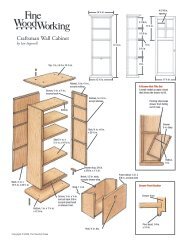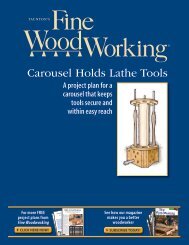Create successful ePaper yourself
Turn your PDF publications into a flip-book with our unique Google optimized e-Paper software.
<strong>Snow</strong> <strong>Fooling</strong><br />
Short row a chin,<br />
unravel a mouth,<br />
and doubledecrease<br />
a nose<br />
by Meg Swansen<br />
t<br />
78 www.threadsmagazine.com<br />
Threads Magazine
Meg Swansen’s masks are perfect blank<br />
canvases for any weirdness you can imagine<br />
knitting. Try any technique that appeals<br />
but doesn’t seem suitable for conventional<br />
projects. You’ll find the basic<br />
pattern for “Pointy-Head” (lower left on<br />
facing page) at right. (Photo by S. Kahn)<br />
December 1991/January 1992<br />
i<br />
t all began innocently enough<br />
with a request for a warm, knitted,<br />
woolen snowmobile helmet. One<br />
thing led to another, and I soon<br />
found myself enmeshed in my<br />
Knitted Mask Period—from which<br />
I have not yet emerged. After all, I have not<br />
even touched the possibilities of colorpatterned<br />
faces. Think of it: ears, glasses,<br />
mustaches, wrinkles, and warts—all<br />
in glorious, living color.<br />
If you feel somewhat taken aback upon<br />
initial confrontation with these masks,<br />
give them a chance. Just wait until you<br />
knit one and crawl inside; you will feel<br />
positively transformed.<br />
<strong>The</strong>re are at least two ways to approach<br />
your own design. With either, you need<br />
your gauge, basic measurements (head<br />
circumference, and length from chin to<br />
nose, nose to eyes, eye to eye, etc.), and<br />
construction techniques. You may then<br />
either carefully chart the whole mask<br />
on graph paper or simply cast on, begin<br />
knit ting, and allow yourself to be inner<br />
directed. I think these masks knit up so<br />
quickly because there is nearly always<br />
something going on, not to mention the<br />
strange fascination of watching a head<br />
emerge from your needles.<br />
I recommend that you loosely follow<br />
my instructions for the plain creamcolored,<br />
pointy-headed version, shown at<br />
far left on the facing page. <strong>The</strong>n peel off<br />
on your own, and knit subsequent helmets<br />
in a freeform mode. If you have no<br />
skiing or snowmobiling recipients, there<br />
is always Halloween to lurk for.<br />
You start the circularly knit masks at<br />
the lower edge with a ribbed section. After<br />
the ribbing, “feel” your way up the<br />
face as you knit: Here comes the chin.<br />
I’ll work a series of short rows across the<br />
front. <strong>The</strong>y’ll bulge out to accommodate<br />
a forceful chin. To shape the back of the<br />
head more or less anatomically, I’ll mark<br />
the center-back stitches, and work an<br />
increase each side every second round<br />
three or four times, as needed.<br />
Now the mouth—l’ll leave that alone<br />
for the time being and work an “afterthought<br />
mouth” at the end. Or: I know<br />
I want the mouth right here, so I’ll perform<br />
the “thumb trick” over these stitches.<br />
(Knit the mouth stitches in a contrasting<br />
color; replace those stitches onto<br />
the left needle; and reknit them in the<br />
main color. Later, remove the contrasting<br />
color to reveal two neat little rows of<br />
stitches waiting to be finished off.)<br />
Aha! I’m at the nose. I’ll cast off a few<br />
stitches for a breathing hole, and when<br />
I come back around to the hole, I’ll cast<br />
on 11 to 13 or even 15 stitches in their<br />
place (depending upon the size wanted—<br />
or needed—for the beak). Now, as I knit<br />
around, I’ll work a double decrease at the<br />
nose center every second or third round,<br />
until the stitches disappear. (Frequency<br />
of decrease greatly affects length and<br />
profile of the nose.) As for the eyes, they<br />
get the same treatment as the mouth.<br />
And suddenly I’m at the crown.<br />
You are now faced with dozens of possibilities<br />
for head or hat shapes: tam-o’-<br />
shanter, watch cap, brimmed hat, turban,<br />
or ski cap; pointed, rounded, or flattop.<br />
How about hair? Or a Medusa head<br />
with I-cord snakes? Let yourself go.<br />
As you’ll notice from my pattern and<br />
masks, I use I-cord (idiot cord) a lot; it’s<br />
easy to do and has so many applications.<br />
For I-cord hair, just pick up three stitches<br />
where you want a strand to begin, using a<br />
double-pointed needle. Knit the stitches;<br />
slide them to the other end of the needle;<br />
pull the yarn across behind, and knit<br />
them again—over and over—until the<br />
ropelike cord is long enough.<br />
© www.threadsmagazine.com<br />
Step-by-step directions for<br />
the basic Pointy-Head<br />
Yarn and needles: 4 oz. worsted-weight<br />
wool; a 16-in. circular needle of a size to<br />
produce 5 sts/in. (small), 4 1 ⁄2 sts/in. (medium),<br />
or 4 sts/in. (large); set of same-size<br />
double-pointed needles (d.p.n.).<br />
Lower ribbing: “Pointy-Head” has a deep,<br />
flaring ribbing that lies nicely around<br />
the shoulders. You may use a smaller<br />
size needle if you prefer.<br />
With 16-in. circular needle, cast on 140<br />
sts, join rnd. P5, k2 for 10 rnds.<br />
Next rnd: *p1, p2tog, p2, k2*; rep *-*<br />
around. Work 9 rnds p4, k2.<br />
Next rnd: *p1, p2tog, p1, k2*; rep *-*<br />
around. Work 9 rnds p3, k2.<br />
Next rnd: *p1, p2tog, k2*; rep *-* around.<br />
Work 10 rnds p2, k2—80 sts. Knit 1 rnd<br />
stockinette stitch.<br />
Note: Alternative short, straight lower<br />
edge: Cast on 80 sts; k2, p2 for 3 to 4 in.<br />
Chin: Mark center-front st for short rows.<br />
Knit 6 sts beyond marker. Wrap, turn<br />
(see Basics, which starts on p. 16), purl<br />
back 12 sts. Wrap, turn, k15. Wrap, turn,<br />
p18. Wrap, turn, k21. Wrap, turn, p24.<br />
Wrap, turn, k27. Wrap, turn, p30. Wrap,<br />
turn, and knit around.<br />
Back-of-head shaping: Mark center-back<br />
2 sts. Inc 1 st each side of marked sts every<br />
2nd rnd, 4 times—88 sts.<br />
Mouth: Ignore for now. Knit around until<br />
you are about 3 in. above back ribbing<br />
(approx. 4 in. above front ribbing). Try<br />
on for nose placement.<br />
Nose: Bind off 4 sts at center front–<br />
84 sts.<br />
Next rnd: With single cast-on (see Basics),<br />
make 13 sts over bind-off—97 sts. K1 rnd.<br />
Next rnd: Work 5 of the cast-on sts; double<br />
dec next 3 sts into 1 as foll: Sl2tog<br />
kwise-k1-p2sso (see Basics). Mark this<br />
st with safety pin for center of next double<br />
dec. K 1 rnd plain. Alternate dec and<br />
plain rnds 5 more times. (For hooked<br />
nose, make last 2 dec rnds consecutively.)<br />
Cast-on sts reduced to 1—85 sts.<br />
Eyes: Ignore for now. Knit until you are<br />
about 1 1 ⁄2 in. above bridge of nose.<br />
Hat demarcation: “Horizontal Stitch,”<br />
from Mary Walker Phillips’ Creative<br />
Knit ting (Dos Tejedoras Fi ber Arts Publi<br />
ca tions, rev. ed. 1986) followed with a<br />
purl round makes an attractive braidlike<br />
band. Or simply work one or two purl<br />
rounds, change color, or whatever. Dec 1<br />
st in last demarcation rnd for a total divisible<br />
by 3—84 sts.<br />
Pointy-head crown: Divide 84 stitches<br />
into 3 groups of 28; work a single dec at<br />
each marker every 2nd rnd. If you use<br />
SSK, the decs will swirl to the left; k2tog<br />
will swirl to right. For a straight dec line,<br />
use a double dec as on nose every 4th<br />
round. Continue around, changing to<br />
d.p.n. when sts become too few for circular<br />
needle. When 3 sts rem, either finish<br />
off, or add a few inches of 3-st I-cord for a<br />
super-pointy top.<br />
Finishing: Try the thing on, and mark<br />
eye positions with a blunt needle. Snip<br />
a st (half a st, actually) in the middle of<br />
where an eye is to be, and ravel 3 to 4 sts<br />
in each direction. Pick up the raw sts top<br />
and bottom, and 2-st I-cord them as foll:<br />
On d.p.n., cast on 2 sts; transfer them<br />
to the pick-up needle, and *k1, k2tog-b<br />
(knit 2 sts together through back loops).<br />
Replace the 2 sts onto the LHN, and rep<br />
from * around each eye. Weave the end to<br />
the beginning.<br />
Rep for mouth—adding a sneer with extended<br />
I-cord, if so inclined.<br />
Note on alternative features: If you<br />
prefer, chart purl stitches for chin and<br />
eyebrows. Measure carefully so you’ll<br />
know where to place them. If the eyes are<br />
hard to see through, fold up flaps for eyelids<br />
and tack in place, as I did on “Aran<br />
Mask with Fair Isle Hat.” You can lower<br />
a hat that looks too high, as on “Dia gonal-<br />
Patterned Face” (facing page, center) by<br />
adding applied I-cord bands below it.<br />
Meg Swanson, owner of Schoolhouse <strong>Press</strong><br />
teaches and writes prolifically.







